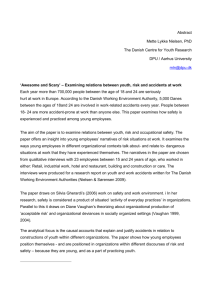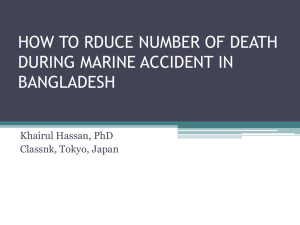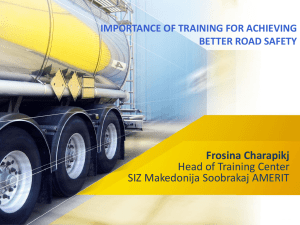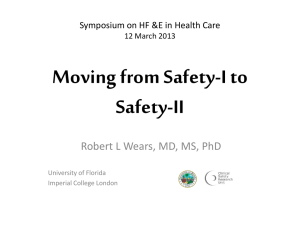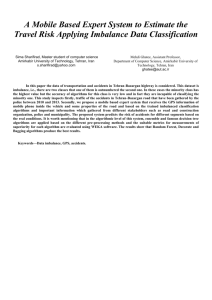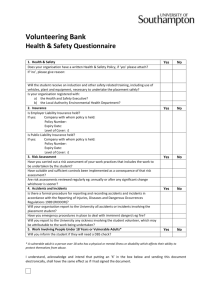- Repository@Napier
advertisement
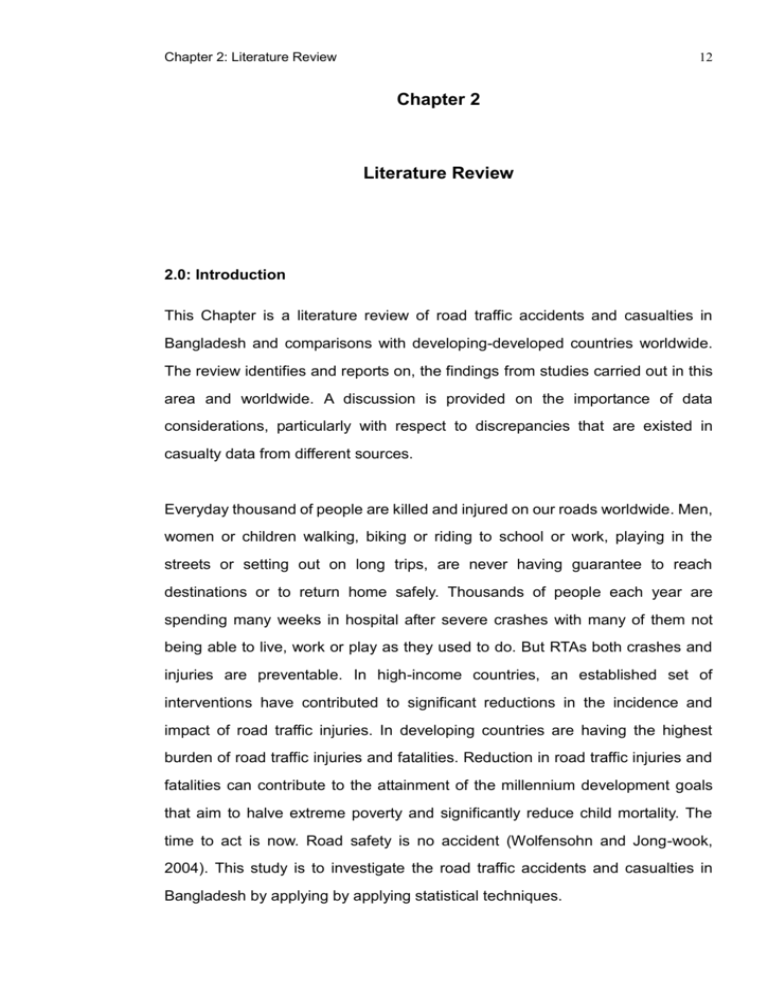
Chapter 2: Literature Review 12 Chapter 2 Literature Review 2.0: Introduction This Chapter is a literature review of road traffic accidents and casualties in Bangladesh and comparisons with developing-developed countries worldwide. The review identifies and reports on, the findings from studies carried out in this area and worldwide. A discussion is provided on the importance of data considerations, particularly with respect to discrepancies that are existed in casualty data from different sources. Everyday thousand of people are killed and injured on our roads worldwide. Men, women or children walking, biking or riding to school or work, playing in the streets or setting out on long trips, are never having guarantee to reach destinations or to return home safely. Thousands of people each year are spending many weeks in hospital after severe crashes with many of them not being able to live, work or play as they used to do. But RTAs both crashes and injuries are preventable. In high-income countries, an established set of interventions have contributed to significant reductions in the incidence and impact of road traffic injuries. In developing countries are having the highest burden of road traffic injuries and fatalities. Reduction in road traffic injuries and fatalities can contribute to the attainment of the millennium development goals that aim to halve extreme poverty and significantly reduce child mortality. The time to act is now. Road safety is no accident (Wolfensohn and Jong-wook, 2004). This study is to investigate the road traffic accidents and casualties in Bangladesh by applying by applying statistical techniques. Chapter 2: Literature Review 13 Section- 2.1 Literature Review Approaches A literature of traffic accidents and casualties in Bangladesh and comparisons with developing-developed countries worldwide will be reviewed as approaches. The review identifies and reports on, the findings from studies into this area across the world. A discussion is provided on the importance of data considerations, particularly with respect to discrepancies that are being existed in accident-casualty data from different sources. Much of the recent research will be focussed here. This will be possible because of straightforwardness of access to increasing amounts of traffic accident-casualty data and other relevant information from local, national and international authorities and departments. It is often the case that findings may conflict between/ among different studies. This is sometimes due to difference in the type of data being interrogated by different researchers, and the incompatibility of data sources used, even from within the same country. Research into RTACs involvement is conducted in many countries. Many of the studies are to be reviewed in this chapter to be provided valuable information on importance of RTACs analysis. Road traffic accidents in different countries are considered at next section (2.2). Section- 2.2 Road Accidents with Casualties in Developing-Developed Countries This section is based on road traffic accidents with casualties in developing and developed countries. Firstly, accidents with casualties as health, social and economic disaster are reviewed. Then, global and regional trends in road traffic deaths; world report on traffic injuries and costs; long-term effects relating to road traffic accidents; Accidents in developing countries; and finally, key indicators in developing- developed countries categorised into six zones are reviewed. Chapter 2: Literature Review 14 2.2.1: Accidents with Casualties as Health, Social and Economic Disaster Of the total 1.2 million of deaths, by far the majority- over 80% of traffic Fatalities occur in so called developing and emerging countries, even though these countries account only about ⅓ of total motor vehicle fleet. Accident rates in developing countries are often 10-70 times higher than in developed countries. The escalating road safety problem in developing world thus represents serious health, social and economic disaster. Developing countries suffer staggering annual loss exceeding US$ 100 billion for accidents, which is nearly equivalent to double of all developing assistances (Hoque, 2001). According to Jacobs et al. (1997), the road safety problem in developing countries may be much worse than the official statistics suggest because of widespread underreporting of road accident deaths and an over estimate of licensed vehicles resulting from scraped vehicles tending not to be removed from the vehicle register. Nantulya et al., (2002) have reported that poor people in developing countries have the highest burden of injuries and fatalities due to traffic accidents. In 1998, more than 85% of deaths and 90% of disability adjusted life years lost worldwide due to road traffic accidents occurred in developing countries. The vast majority of traffic accidents in developing countries comprises vulnerable road users (i.e., pedestrians, bicyclists and motorcyclists) and are most prevalent in urban areas. Trucks and buses are over involved in a majority of fatal accidents and these are the most common vehicles to strike pedestrians. 2.2.2: Global and Regional Trends in Road Traffic Deaths According to WHO data (2004), traffic deaths have risen from approximately 999,000 in 1998 to just over 1.1 million in 2002, an increase of around 10%. Low-income and middle-income countries account for majorities of these increases. Reductions in traffic fatalities in high-income countries are attributed largely to the implementation of a wide range of road safety measures, including seat-belt use, vehicle crash protection, traffic-calming interventions and traffic law enforcement. However, the reduction in the reported statistics for the road traffic Chapter 2: Literature Review 15 injury does not necessarily mean an improvement in road safety for every one. 2.2.3: World report on Traffic Injuries and Costs According to the President (now Ex-President) of France, Mr. Jacques Chirac (WHO, Geneva, April 2004), every year, according to the statistics, 1.2 million people are known to die in road accidents worldwide. Million of others sustain injuries with some suffering permanent disabilities. The report included that worldwide an estimated 1.2 million people are killed in road accidents each year and as many as 50 million are injured. Projections indicate that these figures will increase by about 65% over the next 20 years unless there is new commitment to prevention. Furthermore, road traffic deaths are predicted to increase by 83% in low income and middle income countries and to decrease by 27% in high income countries (WHO, Geneva, April 2004). Haddon Matrix illustrated the interaction of three factors- human, vehicle and environment during three phases of a crash event: pre-crash, crash and post-crash; can be applied to reduce the exposure to risk; prevent the road traffic crashes from occurrence; reduce the severity of injury in the event of a crash; and reduce the consequences of injury through improved post-collision care (WHO, Geneva, April 2004). Haddon matrix is shown below: Factors Phase Pre-crash Crash prevention Crash Injury prevention Human Vehicle and Equipment Environment Information Roadworthiness Lighting Road design and layout Attitudes Braking Speed limits Impairment Handling Pedestrian facilities Police enforcement Speed management Use of restraints Occupant restrains Impairment Other safety devices during crash Post-crash Life sustaining Crash-protective roadside objects Crash-protective design First-aid skills Ease of access Rescue facilities Access to medics Fire risk Congestion Figure- 2.2.3: The Haddon Matrix (Source-Wikipedia: http://en.wikipedia.org/wiki/Haddon_Matrix on 9 June 2007) Chapter 2: Literature Review 16 2.2.3.1: The estimated costs of Road Traffic Accidents In 2000, road accidents’ cost is as follows (WHO, Geneva, 07 April 2004): Currency Country Comment Local US/ British Bangladesh BDT 38,994.48m $745m, £492.35m 1.6% of GNP South Africa ZAR 13.89b $2b, £1.32b Nil Uganda UGX 167,165.7m $101m, £66.75m 2.3% of GNP European € 180b $165.9b, £109.64b Twice the annual budget for all activities in these countries. Union Various studies done in the 1990s produced estimates of 0.5% GDP in UK, 0.9% in Sweden, 2.8% in Italy and an average of 1.4% of GDP in 11 high-income countries. USA $ 230.6b £152.4b 2.3% of GNP *Currency Rate is as US $ 1.00 = GB £ 0.66087 = BDT 52.34158 = EU € 1.08500 = ZAR 6.94303 = UGX 1655.1057 (Average of 366 Days of 2000) according to http://www.oanda.com/convert/fxhistory. Table- 2.2.3.1: Traffic injuries’ costs of Bangladesh and some other countries 2.2.3.2: Costs to Families in Victimisation of Traffic Accidents Those in the 15-44 years old age group account for more than half of all road traffic deaths and 73% of the people killed are male. A recent study in Bangladesh found that 21% of traffic deaths occurred to household heads among non-poor people versus 32% among poor people. ¾ of all poor families who had lost a member to traffic deaths reported a decrease in their standard of living and 61% reported that they had to borrow money to cover expenses following their loss (WHO, Geneva, April 2004). 2.2.4: Long-Term Effects relating to Traffic Accidents Those not killed in RTAs may suffer from permanent disabilities, typically to the brain, spinal cord or lower limb joints. In the EU alone, 150,000 people are left permanently disabled by road accident each year. A study in Bangladesh found that 70% of families experienced a decline in household income and food consumption after a traffic death. Victims and their family members frequently experience depression, travel-related anxiety and sleep disturbance for years after a crash (Lauren et al., 2004). Chapter 2: Literature Review 17 2.2.5: Accidents in developing countries: who are liable and victimised? Eke (2001) found that in developing countries, roads are poorly built and are poorly maintained. As a result, the roads have become death traps. Vehicles are poorly maintained due to poverty, ignorance and corruption among enforcement agents. An unpublished report by Atkins (1998), in which road casualties in four developing countries were inter-reviewed, found clear evidence that poorer sectors of community were much more likely to be involved in road crashes than those who were better educated and with higher personal or household incomes. Similarly, a study by Santikarn in Thailand (Weinstein, 2003b), found that over 50% of road injuries were either labourers or students. 2.2.6: Key Indicators in Developing-Developed Countries on Accidents In Asia-Pacific Region zone, China and India dominate the region (and in fact lead the world) in terms of traffic deaths. The more motorised countries as Thailand, Korea and Malaysia all lose a larger share of their citizens to traffic deaths with a fatality risk approximately 5 times that of China and India. Bangladesh (with the lowest motorisation level, almost one hundredth that of Malaysia) has the lowest fatality risk but the worst fatality rate of region. Malaysia is reported to have the highest fatality risk in the world. Again, in Central Eastern Europe zone, Russia clearly dominates fatality situation with both half of region’s fatalities and also the highest fatality risk. Russia’s per capita risk of dying in a road crash is over three times that of Ukraine’s (Factbook, 1996). In Latin Central America and Caribbean zone, according to IADB-1998 report that Argentina’s true fatality figure is to be 30% higher than reported while in Brazil, the actual fatalities could be 50-80% higher. Mexico has been excluded, as its fatality reporting is limited to national highways only. Peru is included but its under-reporting is serious with less than two injuries being reported for every road fatality. Venezuela and Nicaragua were reported to have begun collecting casualty data from hospital to supplement police data. Again, in Middle East and Chapter 2: Literature Review 18 North Africa zone, Fatality risk in Saudi Arabia is three times that of Egypt but conversely Egypt has a higher fatality rate (Factbook, 1996). In ‘10 Highly Motorised Countries’, most of them have fatality rates of about 2 or less but the poorest countries (of the region) as Portugal and Greece have rates twice as high and which are the highest in region. Japan had the second largest fatalities but a good safety record with a fatality risks half that of the US and a fatality rate which was 40% lower. Again, in Central and South Africa, traffic fatality toll has grown by over a quarter in some large African countries (e.g., Nigeria, Kenya, Ethiopia, Tanzania, Malawi and Zambia) over the past several years. South Africa, on the other hand, experienced a boom in both motorisation and population while road fatalities, since peaking in 1991, appear to have stabilised at approximately 10,000 fatalities per year (Factbook, 1996). The number of people killed in road crashes in regions of developing world continues to increase, whereas it has been a steady decrease over the last fifteen years or so in the West. For example, between 1987-1995 deaths in Asia-Pacific rose by 40%, in Africa by 26% (excluding South Africa where deaths increased very little) and the Middle East/ North Africa region by over 36%. Road deaths doubled in a few Latin America countries and rose by 16 per cent in Brazil. Central and Eastern Europe showed wide variation with fatalities increasing in Poland by 31% but while decreasing in other countries by about 36%. Conversely road deaths in highly motorised countries fell by about 10% (Factbook, 1996). Characteristics of road traffic accidents are considered at next section (2.3). Chapter 2: Literature Review 19 Section- 2.3 Characteristics of Road Traffic Accidents in Bangladesh This section is based on literature review of characteristics of accidents. Firstly, characteristics in road accidents with casualties are reviewed. Then, traffic accidents with casualties and involved vehicles are reviewed. 2.3.1: Characteristics in Road Traffic Accidents with Casualties Hoque et al. (2003) found that the principal contribution factors of accidents are adverse roadside environment, poor detailed design of junctions and road sections, excessive speeding, overloading, dangerous overtaking, reckless driving, carelessness of road users, failure to obey mandatory traffic regulations, variety of vehicle characteristics and defects in vehicles. Others include a low level of awareness of the safety problem by policy makers, inadequate and unsatisfactory education, safety rules and regulations and inadequate and unsatisfactory traffic law enforcement and sanction. 2.3.2: Road Traffic Accidents Accident type analysis showed that hitting pedestrian is the dominant accident type both in urban and rural areas with 45% involvement in fatal accidents. Other common accident types are as rearing end (16.5%), heading on (13.2%) and overturning vehicle (9.3%). These four types account for nearly 85% of the fatal accidents. Indeed the running-off-road accident has the highest rate of about 19 casualties per accident (Hoque et al., 2003). The predominant type of fatal collision on any type of road and in either an urban or rural locality is a vehicle hitting a pedestrian. The half of all fatal accidents being collisions where a vehicle hits a pedestrian is evident in all divisions and cities. Minor changes are noticed showing improvement compared to previous year (55%) in total hit pedestrians. The range is 42%-75%. Dhaka city (75%) and Chapter 2: Literature Review 20 Rajshahi city and Khulna city are at the upper end of the range. The incidence of hit pedestrian is the highest on national highways. More than half of fatal victims of traffic accidents are pedestrians. Physical works which either provide a safer environment for pedestrian (e.g., speed limit zones) or provide safer pedestrian facilities (e.g., footpaths, full width shoulders, pedestrian over-bridges) are the types of measures which can address this safety problem. Most importantly, reckless behaviours of drivers of buses and trucks will need to be controlled. Following hitting pedestrian, heading on, rearing end and overturning are other major collision types in rural localities that account for a high proportion of fatal accidents. Dangerous driving, reckless overtaking and over-speeding are some of the factors responsible for these types of accidents. Of course, badly designed and constructed roads are also a contributing factor. Dhaka city and Rajshahi city have comparatively high fatal accident rates (more than twice that of any other city) with a predominance of pedestrian accidents and rear end accidents (BRTA, 2007). 2.3.2.1: Road Traffic Casualties In Bangladesh, KSI casualty rates are higher in cities than in non-cities (BRTA, 2006). Chowdhury (2006) found that traffic fatalities per 10,000 motor vehicles are 137.4, 143.1, 142.6, 123.2, 126.2, 116.1, 102.9 and 97.5 in 1998 to 2005 respectively. Again, Hoque (2004) found that traffic fatalities per 10,000 motor vehicles are 122.1, 107.1, 110.1, 112.1, 138.2, 128.1, 140.4 and 162.9 in 1993 to 2000 respectively. According to Hoque et al. (2003), Drivers in 26-45 years of age constitute the most dominant group involved in accidents as revealed in the analyses of 8,500 drivers. The overall age distributions of drivers’ involvement in accidents: Age group 26-35, 51.8% (26-30, 24% and 31-35, 27.8%); 36-45, 27.3%; 16-25, 16.3%; 46-55, 3.4%. Out of 8,500 drivers with recorded information, about 4,480 were heavy vehicles’ drivers which accounted for nearly 52.8% of total drivers’ Chapter 2: Literature Review 21 involvement in the casualties with Bus drivers (minibus inclusive)-28%, Truck drivers (heavy trucks, articulated trucks and oil tankers inclusive)-24.6%, Car drivers (microbuses, jeeps and pick ups inclusive)-14.5%, Baby taxi drivers (tempos inclusive)-11.5%, Rickshaw pullers (push carts inclusive)-7.7%, Motor cyclists-5.8% and Bicyclists-4.6%. They also mentioned that the overall child involvement in road accident fatalities in Bangladesh is found to be very high, accounting for about 22%. It is important to note that compared to industrialised countries, the proportion of fatalities to under 15 years of age in developing countries is approximately 2.5 times higher. Of the total child fatalities of road accidents, nearly 82% are involved as pedestrians with the dominant age group of 5-10 years. Indeed, about 1/3 of total pedestrian fatalities are children under the age of 15 years. The female child pedestrians are disproportionately higher than the male child pedestrians (44.6% Vs 28.9%). According to Aeron-Thomas et al. (2004) that girls accounted for a larger share of total female deaths and injuries (32%) than boys did for total males (12%). This was consistent with the draft findings of the Bangladesh Health and Injury Survey that found the mortality rate for transport injuries was much higher for girls under the age of 10 than for boys (Rahman, 2003). According to White (2002), Child passenger casualty numbers in Britain are particularly high in conditions where it is raining or snowing. Over 18% of child passenger casualties occurred while it was raining compared to 7% of cyclists and 9% of pedestrians. A study in India (Mishra et al., 1984) found that motorcyclists benefited from any type of helmet with padding, whereas a study in USA (Peek-Asa et al., 1999) found that the non-standard helmets used by half of all motorcyclists produced more frequent head injuries than not wearing a helmet at all. Among moped and motorcycle riders, head injuries account for about 75% of deaths in Europe (COST 327, 2001) and 55-88% in Malaysia (Radin, 2002).One study (Kulanthayan et al., 2000) found that riders without helmets were 3 times more Chapter 2: Literature Review 22 likely to sustain head injuries than those with helmet. Another (Servadei et al., 2003) found that helmets reduced fatal and serious head injuries by 20-45%. Fell et al. (2008) found that 52% of the offenders were considered problem drinks, 46 were repeat offenders, 57% were classified as hardcore drinking drivers, 51% were drinking at a bar or restaurant before their arrest, and 72% were drinking beer before their arrest, analysing data for drinking characteristics of drivers arrested for driving while intoxicated, of 1027 drivers arrested by police for DWI or DUI in two communities on their alcohol consumption in USA. 2.3.2.2: Involvement in Accidents by Vehicles Type Hoque et. al., (2003) found that over involvement of truck and buses are particularly prevalent in Bangladesh. Earlier studies of police reported accidents on a section of Asian highways revealed that trucks and buses (including minibuses) accounted for about 72% (truck 34%, buses 20% and minibuses 18%) of the vehicles involved in accidents. This group of vehicles is particularly over involved in pedestrian accidents accounting for about 79% (trucks 37%, buses 20% and minibuses 22%). At some locations, trucks involvement was found to 43-50 %. Bose (2007) found that many accidents occur needlessly and take the lives of innocent people, mainly through the reckless behaviour of the drivers of buses and trucks. Research reliability and limitations are considered at next section (2.4). Section- 2.4 Research Reliability, Validity and Potential Limitations This section is based on literature review of research reliability, validity and potential limitations. Firstly, inconsistency in Bangladesh official data of traffic accidents with casualties is reviewed. Then, survey reports of Bangladesh’s road accidents with casualties by international agencies and finally, outputs in different Chapter 2: Literature Review 23 studies at same area are reviewed. The findings from many of studies cited in this chapter, need to be reviewed with cautions. 2.4.1: Inconsistency in Bangladesh Official Data of RTAs Although the country has no up to date data on recent accidents or crash history but what we have in hand are few indications from where we can start with our limited resources. The available data covering a period of thirteen years indicate that the total number of road accidents was 38,464 and the number killed was 26,363. Thus on an average about 69% deaths were reported, which is less than the global average of 86%. These data, however, have to be accepted with a note of caution. This is because of inconsistency in official data. Besides, there is always the problem of underreporting by the police (Ali, 2003). According to White (2002), few studies are able to adequately take account of exposure to accidents and casualties of individual road users and this is critical in quantifying and understanding their true accidents or casualties. Accident data tend to be limited in the nature of exposure experienced by road users, and often only crude measures of exposure can be inferred. Travel information provided by road users themselves may also be unreliable as the ability to quantify and accurately recall their travelling experiences is likely to be subject to error. There are also limitations in generalisability of findings from studies in terms of driving networks in which road users are travelling. Legal frameworks at national and local levels are likely to influence how road users behave and road networks themselves will vary according to geographic location. The influences of seasonal travel patterns may not exist outside relatively small geographical areas and the influence of weather and other environmental conditions are also likely to be relatively localised. Chapter 2: Literature Review 24 2.4.2: Survey Reports of Bangladesh’ RTACs by International Agencies A survey report by Department for International Development (DFID, UK) concluded that "as few as between 3-13% of road traffic injuries were being reported by police" (Aeron-Thomas, 2000). Other recent studies point out that hospitals are not a good source of data to check the under-reporting of road deaths. This is because families may be reluctant to take bodies to hospital to avoid any post-mortem requirement which could postpone burial. Besides, families may like to avoid the hassle associated with process of post-mortem. A recent study, based on household survey data, concluded that the actual number of road deaths occurring in Bangladesh is at over 8,000 and currently estimated to be 12,786, which is at least 2.6-4.2 times greater than that included in official statistics according to Transport Research Laboratory, UK (Ali, 2003). According to Aeron-Thomas et al. (2004), in 2000 the police recorded 3,058 road deaths and 2,270 serious injuries in Bangladesh but these would have been 12,500 road deaths and 170,000 serious injuries. This is 4 times greater than fatalities and almost 75 times greater than serious injured officially reported by the police. Traffic fatalities and serious injuries are estimated to be 34 times that officially recorded. It should also be noted that in 2001, the police reported a decrease in road deaths and serious injuries with 2,388 road deaths and 1,661 serious injuries, so the under-reporting problem may be worsening. 2.4.3: Outputs in Different Studies at Same Area Even for improved data resources, it can be difficult to draw clear conclusions fro research of accidents and casualties. It is often the case that findings conflict among/ between different studies. This is sometimes due to differences in the type of data being interrogated by different researchers and the incompatibility of data sources used, even from within the same country. Research into road traffic accident involvement is conducted in many countries and the influence of contributory factors may vary between these countries. Similarly, definitions for different class of road users and casualty severities, together with age Chapter 2: Literature Review 25 groupings, can also be inconsistent across national boundaries (White, 2002). Many of studies reviewed in this chapter have provided valuable information on important factors/ attributes associated with road traffic accidents and casualties. Certain attributes are found to be associated with accident or casualty in multiple studies and should be valued accordingly. In addition to these particular issues, the research already cited in this chapter needs to be considered in terms of reliability and validity of the data used in this study. Next section (2.5) is for consideration and collection of data. Section- 2.5 Collection of Data and Considerations This section is based on literature review of collection of data and considerations. Firstly, sources and types of traffic accidents with casualties’ data in Bangladesh are reviewed. Then, scope and qualities of accidents and official data; dual data features; and interpretation of accidents and casualties data by Bangladesh road transport authority are reviewed. 2.5.1: Sources and Types of Accidents and Casualties Data in Bangladesh For research, the secondary data on traffic accidents and casualties in Bangladesh have been collected from Bangladesh Road Transport Authority, RTA Annual Reports- 2001 to 2006; Bangladesh Police HQ and Bangladesh Bureau of Statistics. The data from BRTA setting the standard for annual RTA by reporting with full and comprehensive tabulation of national statistics for road accidents in which casualties are involved and for casualties (fatalities and injured persons), are as casualty accidents with by divisions and cities, by type of collision, by type of junction, by type of vehicle involved, by month, week and time of day; and casualties with by divisions and cities, fatalities by age and road user group, passenger fatalities by age and gender and pedestrian fatalities by Chapter 2: Literature Review 26 age and gender (BRTA, 2006). According to Chowdhury (2006), the data sometimes differ between FIR (First Information Report by police) and MAAP (Micro-computer Accident Analysis Package, developed and produced by TRL, UK). BRTA and the Road Safety Cell are aware of a possibly considerable level of under-reporting of road traffic statistics- not all traffic accidents are registered on a FIR and not all accidents reported as FIRs are entered on an Accident Reporting Form (BRTA, 2005). 2.5.2: Scope and Qualities of Accidents and Official Data There are often problems in matching incidents and individuals involved in fatal/ grievous accidents correctly due to the scopes and qualities of accidents and official data improved dramatically in recent years. If accurate data are unavailable, there will always be uncertainties as to the true nature of the relationships between certain variables i.e., accidents and casualties (White, 2002). Dhillon et al., (2001) argue that there is a need to use multiple sources of data to improve the accuracy of recording incidence rates. 2.5.3: Dual Data Features An extensive review of data collection and reporting system revealed two important features in Pakistan. Since 1991, government documents have started using total number of registered vehicles instead of vehicles on road for accident fatalities and other rates related with number of vehicles. This change in denominator is more consistent with the reporting from other countries but requires caution for interpreting such rates. For example, fatalities per 10,000 vehicles for 1996 would be 35 when vehicles on road are used and only 16 when registered vehicles are used as a denominator. This represents a halving or doubling of the rate when one or the other denominator is used for crash related rate calculations (Shahid et al., 2006). Chapter 2: Literature Review 27 2.5.4: Interpretation of Traffic Accidents and Casualties Data by BRTA Interpretation of accident data presented herein can be undertaken with a measured degree of confidence when establishing accident profiles or when comparing accident rates by district, division or city. Caution is advised however when making comparison of safety performance with that of other countries or when trying to determine an absolute value of total accident occurrence. It needs to be recognised that these recorded RTAs only represent a fraction of the total number of accidents that occur on the roads in Bangladesh. Under-reporting of RTAs has a number of reasons, of administrative, social or political nature. One important circumstance is that accidents only tend to be recorded if they result in immediate fatalities. Many accidents in which a victim of an accident dies away from the scene of the accident (such as in hospital) will not be recorded. Similarly, in multiple-fatality RTAs, only those that died immediately at the scene of the accident will be recorded in the police report (BRTA, 2006). Research questions are considered at next section (2.6). Section- 2.6 Key Research Questions On the basis of the above theoretical review and empirical findings, the thesis will attempt to answer the following questions: a) Who are involved in road traffic accidents? b) Where do road traffic accidents occur? c) How the vehicles are involved in road traffic accidents? d) How can road traffic accidents with casualties be reduced? e) What are the causes of road traffic accidents with casualties? f) What are the results of road traffic accidents with casualties? g) What are the problems/ conflicts/ issues of accidents with casualties? h) What are the possible solutions to these problems/ conflicts/ issues? Chapter 2: Literature Review 28 i) How much is the estimated direct cost of traffic accidents and casualties? This chapter is concluded at Next section (2.7). Section- 2.7 Conclusion The frequencies/ rates of traffic accidents and casualties in Bangladesh and worldwide, particularly developing countries have been increasing rapidly in recent years, particularly in terms of fatalities (killed) and serious injuries. The above literature review attempts to contribute to the identity of the magnitude of accidents and casualties, to the prediction of KSI/ fatal accidents-casualties and to the analysis of involved characteristics for the statistical analysis of traffic accidents in Bangladesh. The analysis of traffic KSI accidents and casualties are well worth to be carried out, not only for reducing the huge cost, but also to provide a comprehensive exploration related factors. Data are explored at next chapter (3).


